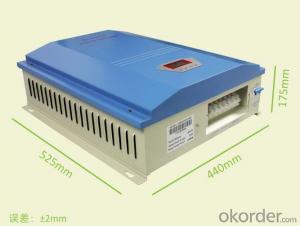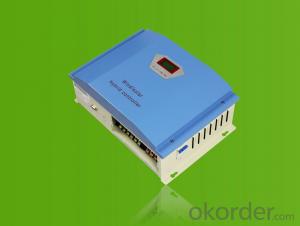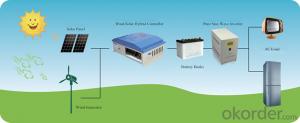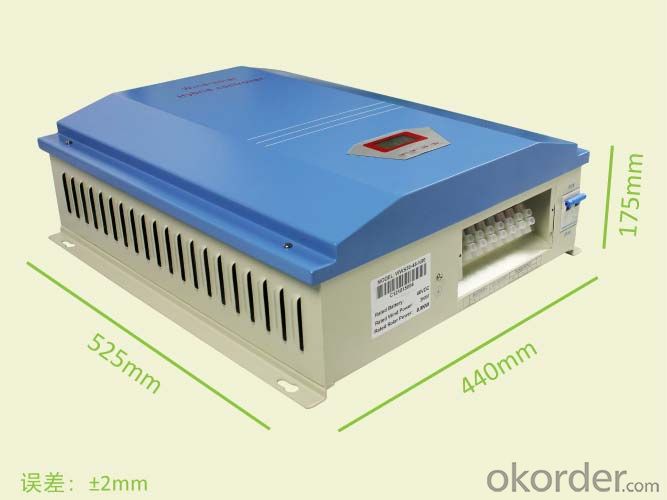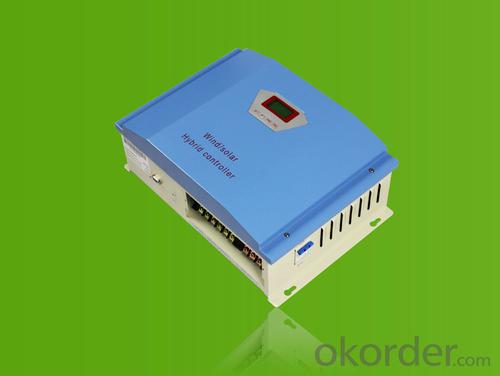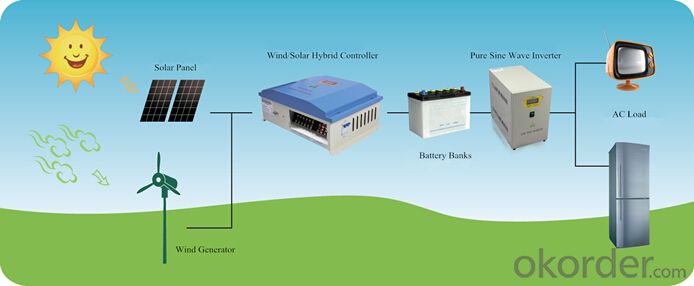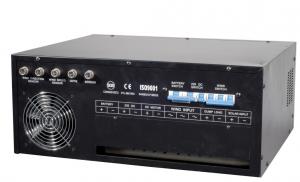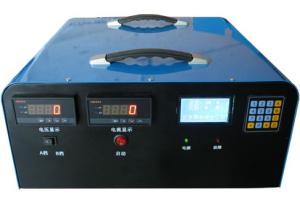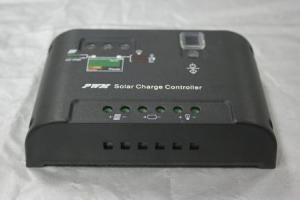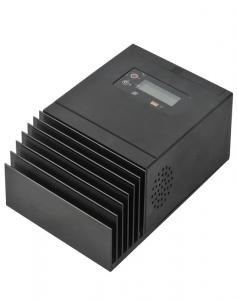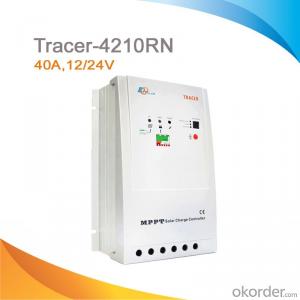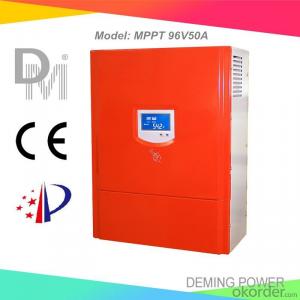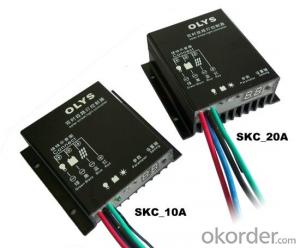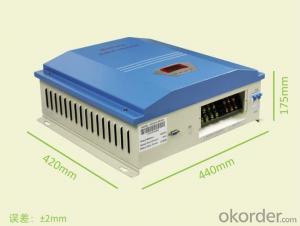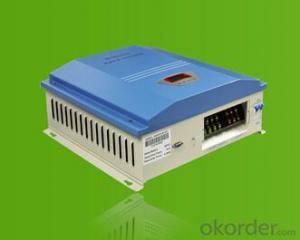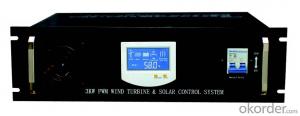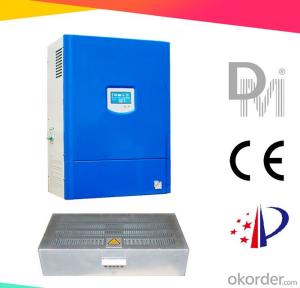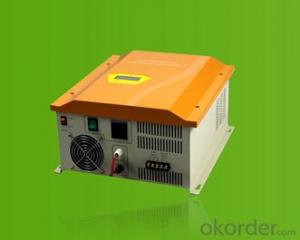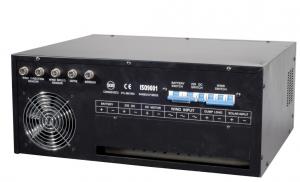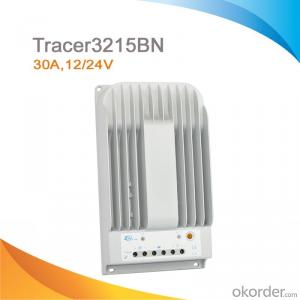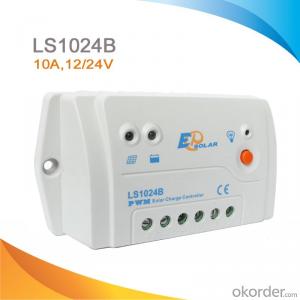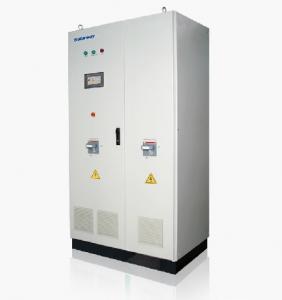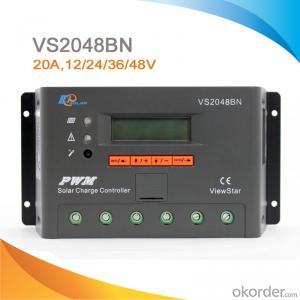Solar Controllers Amazon - Wind Solar Hybrid Controller 3kw PWM Stepless Unload Mode
- Loading Port:
- Shanghai
- Payment Terms:
- TT or LC
- Min Order Qty:
- 1 unit
- Supply Capability:
- 5000 unit/month
OKorder Service Pledge
OKorder Financial Service
You Might Also Like
I. PRODUCT INTRODUCTION
The wind/solar hybrid controller is the control device which can control wind turbine and solar panel at the same time and transform wind and solar energy into electricity then stores to the battery bank.Wind/solar hybrid controller is the most important part in off-grid system, whose performance has much effect on life expectancy and operational stability of the whole system, especially the battery expectancy. Or battery service life will be shortened by over-charge or over-discharge.
II. PERFORMANCE FEATURES
Superior military-grade components to ensure the product stability.
Perfect protection function, thus the system has higher reliability.
Check and set all operation parameters as requirement from LCD display.
Voltage limiting and current-limiting charge mode ensures battery in the best charging status.
PWM stepless unload mode, which burn the excess power into dump load, making the battery charging in best status.
III. APPLICATION AREAS
Stand alone wind/solar hybrid power station; Stand alone domestic household wind/solar hybrid power system.
Mobile communication base stations, expressway and other non-residential regions.
Coastal islands, remote mountainous, border posts for regions shortage of or without electricity.
Government demonstration projects, landscape lighting project.
IV. 3KW TECHNICAL PARAMETERS
Product Model | WWS30-48 | WWS30-96 | WWS30-110 | WWS30-120 | WWS30-220 |
Rated Battery Voltage | 48 V | 96 V | 110V | 120 V | 220 V |
Rated Wind Turbine Input Power | 3 kW | 3 kW | 3kW | 3 kW | 3 kW |
Maximum Wind Turbine Input Power | 4.5 kW | 4.5 kW | 4.5kW | 4.5 kW | 4.5 kW |
Wind Turbine Brake Current | 63 A | 32 A | 28A | 25 A | 14 A |
Rated Solar Input Power | 0.9 kW | 0.9 kW | 0.9kW | 0.9 kW | 0.9 kW |
Floating Charging Voltage | 58 V | 116 V | 133V | 145 V | 266 V |
Dimension(L x W x H) | 442×525×172 mm | ||||
Net Weight | 15kg | ||||
Display Mode | LCD | ||||
Cooling | Fan | ||||
Protection Level | IP20(Indoor) | ||||
Quiescent Current | ≤20 mA | ||||
Protection functions | Battery over charge; Battery over discharge; solar reverse charge protection; anti-reverse-connection protection; wind turbine over rotate speed protection; wind turbine over wind speed protection; wind turbine over voltage protection; wind turbine over current protection; manual brake protection; automatically brake protection; lightning protection. | ||||
Ambient Temperature | -20~+55℃ | ||||
Ambient Humidity | 0~93%, without condensing | ||||
Working humidity | ≤4000m | ||||
In order to serve our customers better. Our company can adjust parameters configuration according to customer’s requirement. | |||||
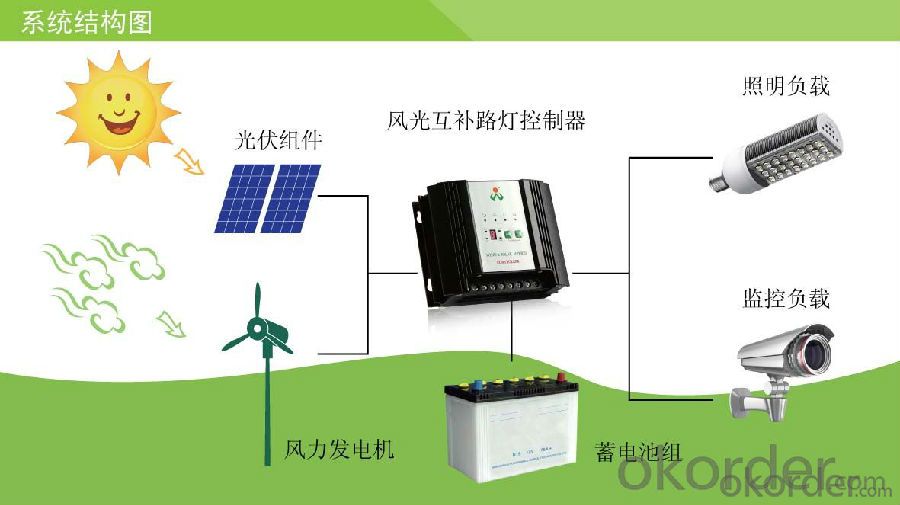
- Q: Can a solar controller be used with a battery bank that is being charged from other sources (e.g., grid, generator)?
- Yes, a solar controller can be used with a battery bank that is being charged from other sources. The solar controller will regulate the charging process and ensure that the battery bank is not overcharged, regardless of whether the charging source is solar panels, the grid, or a generator.
- Q: How do I connect multiple solar controllers together?
- To connect multiple solar controllers together, you will need to follow a few steps: 1. Identify the type of solar controllers you have: Before connecting them together, it's crucial to ensure that the solar controllers are compatible with each other. Check the specifications and features of each controller to verify if they can be connected in parallel or series. 2. Determine the connection method: There are two common methods for connecting multiple solar controllers - parallel and series. Parallel connection involves connecting the positive terminals of all controllers together and the negative terminals together. Series connection, on the other hand, requires connecting the positive terminal of one controller to the negative terminal of the next controller. 3. Connect the solar controllers: Once you have determined the appropriate connection method, you can start connecting the controllers. Ensure that all connections are secure and tight to avoid any loose connections or electrical faults. Use appropriate wiring and connectors depending on the size and type of the controllers. 4. Configure the controllers: After connecting the controllers physically, you may need to configure some settings for them to work together efficiently. Consult the user manuals or documentation provided with the controllers to understand how to configure them correctly. This may involve adjusting charging parameters, setting priority modes, or synchronizing the controllers. 5. Monitor and test: Once the controllers are connected and configured, it's essential to monitor their performance and test their functionality. Keep an eye on the charging and discharging patterns, battery voltage, and any error messages or alarms. Regularly check the system to ensure that all controllers are functioning correctly and charging the batteries effectively. Remember, it's important to consult a professional or refer to the manufacturer's guidance if you are unsure about any aspect of connecting solar controllers together. Safety should always be a priority when dealing with electrical connections, especially when it comes to solar power systems.
- Q: What is the purpose of the low voltage disconnect feature on a solar controller?
- In order to safeguard the batteries from over-discharge, the low voltage disconnect feature on a solar controller serves a crucial purpose. When the battery's voltage drops below a certain level, irreversible damage can occur, significantly reducing its lifespan. By monitoring the battery voltage, the low voltage disconnect feature effectively disconnects any load, such as appliances or devices, from the battery once the voltage falls below a predetermined threshold. This action prevents excessive drainage of the battery, ensuring that it retains a sufficient charge for proper functioning and longevity. Consequently, by disconnecting the load, the low voltage disconnect feature plays a vital role in protecting and optimizing the battery's performance within a solar power system.
- Q: How does a solar controller prevent voltage instability in the system?
- A solar controller prevents voltage instability in the system by regulating the flow of electricity from the solar panels to the batteries. It monitors the voltage levels and adjusts the charging process accordingly to ensure a steady and optimal voltage output, preventing overcharging or undercharging of the batteries. This helps maintain a stable voltage within the system, promoting its efficiency and longevity.
- Q: What is the maximum number of load control modes supported by a solar controller?
- The maximum number of load control modes supported by a solar controller can vary depending on the specific model and manufacturer. However, most solar controllers typically support around 4 to 5 load control modes, allowing users to customize and optimize their energy usage according to their specific needs and preferences.
- Q: Can a solar controller handle power fluctuations from appliances?
- Yes, a solar controller is designed to handle power fluctuations from appliances. It regulates the flow of power from the solar panels to the appliances, ensuring a stable and consistent supply of electricity.
- Q: Can a solar controller be used in a solar-powered surveillance system?
- Yes, a solar controller can be used in a solar-powered surveillance system. A solar controller is responsible for regulating the flow of power from the solar panels to the battery storage system. In a solar-powered surveillance system, the solar controller ensures that the battery is charged efficiently and protects it from overcharging or discharging, thereby ensuring uninterrupted power supply to the surveillance equipment.
- Q: How does a solar controller prevent damage to the solar panels during extreme temperature conditions?
- A solar controller prevents damage to solar panels during extreme temperature conditions by regulating and maintaining the voltage and temperature levels within safe operating ranges. During hot temperatures, the solar controller prevents overheating of the panels by reducing the charging voltage or current to prevent excessive heat buildup. This is crucial as excessive heat can lead to thermal stress, delamination, or even cracking of the solar cells. On the other hand, during extremely cold temperatures, the solar controller helps prevent damage by ensuring that the batteries connected to the solar panels are not overcharged or discharged. This is achieved by adjusting the charging algorithm or disconnecting the batteries when the temperature drops below a certain threshold. Additionally, some advanced solar controllers incorporate temperature sensors that monitor the temperature of the solar panels. These sensors provide real-time data to the controller, allowing it to adjust the charging parameters accordingly and prevent any potential damage due to extreme temperature conditions. Overall, a solar controller plays a critical role in protecting solar panels from damage caused by extreme temperatures. By regulating the voltage, current, and battery charging levels, it ensures that the panels operate within safe limits and maximizes their lifespan and performance.
- Q: How does a solar controller handle reverse current flow from batteries to solar panels?
- A solar controller, commonly referred to as a charge controller, plays a vital role in solar power systems. Its main function is to regulate the flow of charge from solar panels to batteries, ensuring optimal charging and preventing any harm or overcharging to the batteries. To address the issue of reverse current flow from batteries to solar panels, a solar controller employs either a blocking diode or a solid-state relay. These components are specifically designed to hinder the flow of current in the opposite direction, thereby safeguarding the solar panels against potential damage caused by the discharge of the batteries. The blocking diode serves as an electricity valve, permitting the current to flow from the solar panels to the batteries while blocking any reverse current. Installed in the wiring between the batteries and solar panels, it effectively prevents the battery discharge from flowing back into the panels. Similarly, more advanced solar controllers can incorporate a solid-state relay. These relays utilize electronic switching components to control the direction of current flow. In instances of reverse current, the solid-state relay promptly detects and thwarts it from reaching the solar panels. By incorporating either a blocking diode or a solid-state relay, a solar controller effectively mitigates the risk of reverse current flow from batteries to solar panels. This ensures the durability and efficiency of the solar power system by maintaining the intended energy flow and shielding the panels from potential damage.
- Q: How do I integrate a solar controller with my existing solar system?
- To integrate a solar controller with your existing solar system, you need to follow a few steps. First, ensure that the solar controller you have is compatible with your solar panels and system specifications. Then, locate the main junction box or connection point of your solar system. Connect the solar controller to this junction box using appropriate wiring and connectors. Make sure to follow the manufacturer's instructions for proper wiring and connections. Finally, configure the settings on the solar controller according to your system requirements and preferences. It is recommended to consult a professional or refer to the user manual for specific guidance tailored to your solar controller model.
Send your message to us
Solar Controllers Amazon - Wind Solar Hybrid Controller 3kw PWM Stepless Unload Mode
- Loading Port:
- Shanghai
- Payment Terms:
- TT or LC
- Min Order Qty:
- 1 unit
- Supply Capability:
- 5000 unit/month
OKorder Service Pledge
OKorder Financial Service
Similar products
Hot products
Hot Searches
Related keywords
